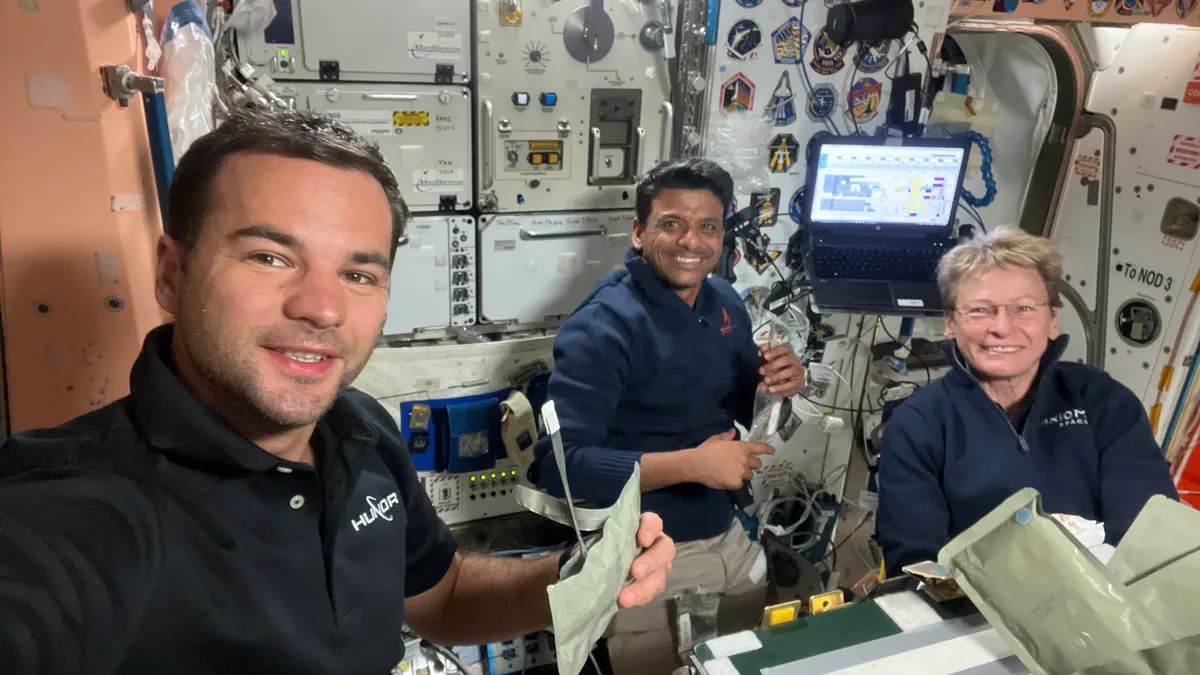Axiom Mission 4: Crew studies cancer cells in space, myogenesis and more on day 6
 Ax-4 Mission Specialist Tibor Kapu takes a selfie with Commander Peggy Whitson and Pilot Shubhanshu Shukla aboard the International Space Statin. | Axiom Space
Ax-4 Mission Specialist Tibor Kapu takes a selfie with Commander Peggy Whitson and Pilot Shubhanshu Shukla aboard the International Space Statin. | Axiom Space
On July 1 2025, at 10.42am IST, the crew of Axiom Mission 4 (Ax-4) continued their scientific work aboard the International Space Station (ISS), bringing pride to India and the world. Led by Commander Peggy Whitson, the team includes Shubhanshu “Shux” Shukla from India as Pilot, along with Mission Specialists Sławosz “Suave” Uznański-Wiśniewski from Poland and Tibor Kapu from Hungary.
Their sixth day in space was filled with scientific research and meaningful outreach, showing how space exploration can benefit people on Earth and prepare us for future missions to the Moon and Mars.
One of the biggest challenges in space is radiation, high-energy particles that come from the Sun and distant stars. While Earth’s atmosphere and magnetic field shield us, astronauts in space are directly exposed to these harmful particles. Radiation can damage DNA and increase the risk of cancer and heart problems. Axiom Space has been working to reduce these risks. Since their earlier missions, they have tested radiation-shielding vests and materials. In Ax-4, the crew is using small tools called dosimeters to measure radiation levels in real time.
One such project, RadMon-on-ISS, led by Polish researchers, is working on developing better radiation sensors. Another initiative from Hungary, called the Rad Nano Dosimeter, records radiation levels and environmental conditions around the crew. These studies will help in designing safer spacecraft and protective suits for future missions.
Day 6 also included key experiments. Commander Peggy Whitson worked on the “Cancer in LEO” study. She took images of tumour organoids—tiny 3D clusters of cancer cells—in microgravity to observe how they grow differently in space. “The research is contributing to the development of a new cancer drug called Rebecsinib, which is now entering clinical trials on Earth to treat aggressive cancers,” remarked space analyst Girish Linganna.
Pilot Shubhanshu Shukla conducted experiments inside a Life Sciences Glovebox as part of the myogenesis study, which explores how and why muscles weaken in space. This research may help astronauts maintain muscle strength during long missions and could also benefit elderly people on Earth who experience muscle loss with age.
Tibor Kapu focused on radiation monitoring using the Rad Nano Dosimeter. This not only ensures the crew’s safety but also provides valuable data for future space missions.
The crew also explored advanced health technologies. They carried out an ultrasound scan for the Telemetric Health AI study, which tracks how space affects heart function and balance. This data can help improve astronaut health and might also support remote healthcare solutions on Earth, especially in areas with limited medical access.
Another fascinating project was the PhotonGrav study. The team tested a brain-computer interface using a special headset that detects brain signals. “This kind of technology could help astronauts operate equipment with their thoughts and may also lead to devices for people with disabilities back on Earth. Tibor also worked on the VITAPRIC study, where he grew microgreens—small, highly nutritious plants in space. These plants could become a valuable food source for astronauts during long missions. The study may also help improve farming methods in places on Earth with poor soil or water scarcity,” explained Linganna.
Mental health was another focus area. The astronauts documented their daily routines and activities as part of the Astronaut Mental Health study. This research aims to understand how astronauts stay mentally strong in space and could guide mental health support for people living in isolated or challenging environments on Earth.
The crew also engaged in public outreach. At 3.00pm IST, Tibor Kapu spoke to Hungarian journalists, describing life aboard the ISS. On the following day, around 2.30pm IST, Commander Peggy Whitson is scheduled to speak with her Axiom Mission 2 crewmate, Rayyanah Barnawi, along with student winners of the Madak competition. Later, at 4.00pm IST, she will also interact with young women from Mexico, Spain, Germany, and the UK to inspire the next generation of female space explorers.
On the previous day, at 1.00pm IST, Peggy Whitson and Suave participated in a discussion with Dr. Lucie Low, Axiom Space’s Chief Scientist. They spoke about radiation hazards in space and how the Ax-4 team is working to address them.
This mission is not just about space travel; it is about improving life on Earth. Whether it is developing new cancer treatments, growing fresh food in space, advancing medical tools, or protecting astronauts from radiation, the Ax-4 mission demonstrates how space science can lead to real-world solutions.
Sci/Tech